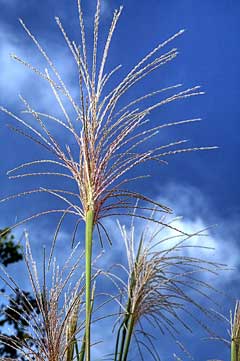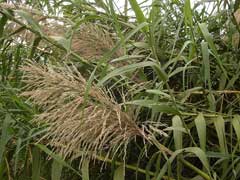 |
|
www.flickr.com/photos/shenghunglin |
 |
| http://commons.wikimedia.org/wiki/User:Tau%CA%BBolunga |
Translate this page:
Summary
Bloom Color: White. Main Bloom Time: Early fall, Late summer, Mid summer. Form: Upright or erect.
Physical Characteristics

 Miscanthus floridulus is a PERENNIAL growing to 2.5 m (8ft 2in) at a fast rate.
Miscanthus floridulus is a PERENNIAL growing to 2.5 m (8ft 2in) at a fast rate.
See above for USDA hardiness. It is hardy to UK zone 6 and is not frost tender. It is in flower from July to August. The species is hermaphrodite (has both male and female organs) and is pollinated by Wind.
Suitable for: light (sandy), medium (loamy) and heavy (clay) soils and prefers well-drained soil. Suitable pH: mildly acid, neutral and basic (mildly alkaline) soils. It can grow in semi-shade (light woodland) or no shade. It prefers moist soil. The plant can tolerates strong winds but not maritime exposure.
UK Hardiness Map
US Hardiness Map
Synonyms
Plant Habitats
Hedge; Cultivated Beds;
Edible Uses
Edible Parts: Flowers
Edible Uses:
The unopened flower spikes are edible[105, 177].
References More on Edible Uses
Medicinal Uses
Plants For A Future can not take any responsibility for any adverse effects from the use of plants. Always seek advice from a professional before using a plant medicinally.
None known
References More on Medicinal Uses
The Bookshop: Edible Plant Books
Our Latest books on Perennial Plants For Food Forests and Permaculture Gardens in paperback or digital formats.

Edible Tropical Plants
Food Forest Plants for Hotter Conditions: 250+ Plants For Tropical Food Forests & Permaculture Gardens.
More

Edible Temperate Plants
Plants for Your Food Forest: 500 Plants for Temperate Food Forests & Permaculture Gardens.
More

More Books
PFAF have eight books available in paperback and digital formats. Browse the shop for more information.
Shop Now
Other Uses
Hedge Hedge
Plants can be grown as a screen. Although they die down in the winter they quickly attain their full height each season[200].
Special Uses
Hedge Hedge
References More on Other Uses
Cultivation details
Landscape Uses:Container, Erosion control, Seashore, Specimen, Winter interest. Prefers a deep fertile loamy soil that does not dry out in summer[200] but it also succeeds in any ordinary soil that is not too dry[1, 162], in sun or light shade[200]. Plants can be grown as a focal point in lawns, they also succeed in quite coarse grass[233]. The young growth in spring can be damaged by late frosts. This species is closely related to M. sacchariflorus[233]. The leaves have saw-toothed edges that can cut the unwary gardener, it is best to wear gloves when working with the plant[200]. Plants seem to be immune to the predations of rabbits[233]. Special Features:
Attractive foliage, Not North American native, Suitable for cut flowers, Suitable for dried flowers.
References Carbon Farming Information and Carbon Sequestration Information
Temperature Converter
Type a value in the Celsius field to convert the value to Fahrenheit:
Fahrenheit:
The PFAF Bookshop
Plants For A Future have a number of books available in paperback and digital form. Book titles include Edible Plants, Edible Perennials, Edible Trees,Edible Shrubs, Woodland Gardening, and Temperate Food Forest Plants. Our new book is Food Forest Plants For Hotter Conditions (Tropical and Sub-Tropical).
Shop Now
Plant Propagation
Seed - surface sow in spring in a greenhouse and keep moist. Germination should take place within a couple of weeks. When they are large enough to handle, prick the seedlings out into individual pots and grow them on in the greenhouse for their first winter. Plant them out into their permanent positions in late spring or early summer, after the last expected frosts. Division in spring or early autumn[200]. Very easy, large divisions can be planted out direct into their permanent positions. We have found that it is better to pot up the smaller divisions and grow them on in light shade in a cold frame until they are well established before planting them out in late spring or early summer.
Other Names
If available other names are mentioned here
Native Range
TEMPERATE ASIA: China (Anhui Sheng, Fujian Sheng, Guangdong Sheng, Guangxi Zhuangzu Zizhiqu, Guizhou Sheng, Hainan Sheng, Henan Sheng, Hubei Sheng, Jiangsu Sheng, Jiangxi Sheng, Sichuan Sheng, Yunnan Sheng, Zhejiang Sheng), Hong Kong, Japan (Honshu (east), Kyushu, Ryukyu Islands, Shikoku), Taiwan TROPICAL ASIA: Indochina, Indonesia (Jawa), Malaysia, Philippines PACIFIC: French Polynesia, Fiji
Weed Potential
Right plant wrong place. We are currently updating this section.
Please note that a plant may be invasive in one area but may not in your area so it's worth checking.
Conservation Status
IUCN Red List of Threatened Plants Status :

Growth: S = slow M = medium F = fast. Soil: L = light (sandy) M = medium H = heavy (clay). pH: A = acid N = neutral B = basic (alkaline). Shade: F = full shade S = semi-shade N = no shade. Moisture: D = dry M = Moist We = wet Wa = water.
Now available:
Food Forest Plants for Mediterranean Conditions
350+ Perennial Plants For Mediterranean and Drier Food Forests and Permaculture Gardens.
[Paperback and eBook]
This is the third in Plants For A Future's series of plant guides for food forests tailored to
specific climate zones. Following volumes on temperate and tropical ecosystems, this book focuses
on species suited to Mediterranean conditions—regions with hot, dry summers and cool, wet winters,
often facing the added challenge of climate change.
Read More
Expert comment
Author
(Labill.)Warb.
Botanical References
58200
Links / References
For a list of references used on this page please go here
Readers comment
© 2010, Plants For A Future. Plants For A Future is a charitable company limited by guarantee, registered in England and Wales. Charity No. 1057719, Company No. 3204567.